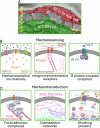Mechanobiology in the eye
- PMID: 40621053
- PMCID: PMC12227313
- DOI: 10.1038/s44341-025-00022-6
Mechanobiology in the eye
Abstract
The eye presents a very dynamic biomechanical environment, and thus ocular cells must be highly mechanosensitive and mechanoresponsive. Moreover, defects in mechanobiological pathways contribute to a number of sight-threatening ocular diseases, highlighting the importance of ocular mechanobiology. We here give a concise overview of the mechanobiology of ocular cells in the lens and cornea (and how mechanobiology plays a role in associated pathologies in these tissues), before providing a detailed review of the mechanobiology of the common blinding disease, glaucoma. Mechanical stimuli are intimately linked with the pathology of glaucoma, both in terms of altered homeostasis of the eye's internal pressure control system and in the response of neural cells to elevated pressure in the eye. A complex array of mechanosensory elements (stretch-activated ion channels, integrins, G protein-coupled receptors) work together with intersecting networks of mechanotransducing pathways in cells of both the posterior and anterior eye in glaucoma. Despite intense research efforts over the past decades, much remains unknown about the mechanobiology of glaucoma. Continued investigation of glaucomatous mechanobiology is important, as it may reveal novel targets for treating this challenging disease.
Keywords: Atomic force microscopy; Diseases; Mechanisms of disease.
© The Author(s) 2025.
Conflict of interest statement
Competing interestsThe authors declare no competing interests.
Figures



References
-
- Brown, M. M., Brown, G. C., Sharma, S. & Busbee, B. Quality of life associated with visual loss: a time tradeoff utility analysis comparison with medical health states. Ophthalmology110, 1076–1081 (2003). - PubMed
Publication types
Grants and funding
LinkOut - more resources
Full Text Sources
Miscellaneous
